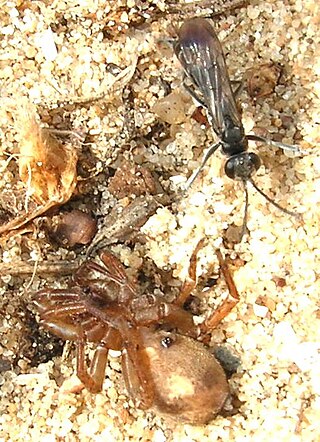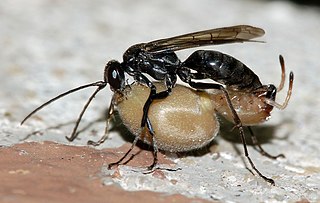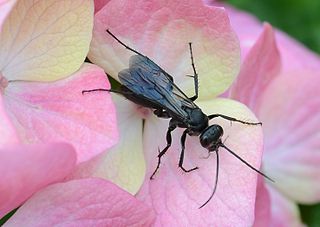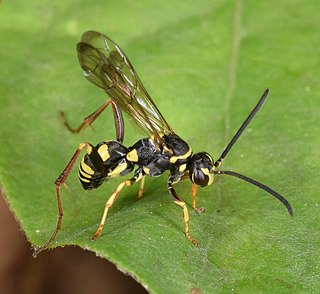
Wasps in the family Pompilidae are commonly called spider wasps, spider-hunting wasps, or pompilid wasps. The family is cosmopolitan, with some 5,000 species in six subfamilies. Nearly all species are solitary, and most capture and paralyze prey, though members of the subfamily Ceropalinae are kleptoparasites of other pompilids, or ectoparasitoids of living spiders.

Steatoda nobilis is a spider in the genus Steatoda, known in the United Kingdom as the noble false widow, as it superficially resembles and is frequently mistaken for the black widow and other spiders in the genus Latrodectus. It is often referred to as thefalse widow, although "false widow" is a more general term applied to a wider group of species with this resemblance. It is a moderately medically significant spider, with most bites resulting in symptoms similar to a bee or wasp sting. Some bites may cause more significant harm, partly due to pathogenic bacteria from the spiders.

Episyron rufipes, the red-legged spider wasp, is a red and black or completely black spider-hunting wasp.

Pompilus cinereus, the leaden spider wasp is the most widespread species of the Pompilus spider wasps, and throughout a large proportion of its wide distribution is the only species of Pompilus. It is the type species of the genus Pompilus and therefore of the family Pompilidae.

Dipogon subintermedius is a spider wasp from the family Pompilidae.

Dipogon variegatus is a pompilid spider wasp in the subfamily Pepsinae from the Palearctic.

Auplopus carbonarius is a spider wasp of the family Pompilidae. Uniquely among the British group it constructs a nest of barrel-shaped cells in which spiders are stored and the larvae develop.

Anoplius nigerrimus is one of the most common spider wasps, or pompilids, in Europe. They are mostly black and the females are 6–8 mm long while males measure 5–8 mm. This species may be distinguished from the related Anoplius concinnus and Anoplius caviventris by the 20 setae, or hairs, on the forehead rather than 60 or 45.

Ceropales maculata is a kleptoparasitic spider wasp found in the holoarctic region.
Evagetes crassicornis is a kleptoparasitic spider wasp with a holarctic distribution.

Arachnospila trivialis is a widespread spider wasp of sandy soil areas of the Palaearctic.
Arachnospila consobrina is a little-known Palaearctic spider wasp.

Agenioideus cinctellus is a spider wasp of the subfamily Pompilinae with a Palearctic distribution.

Caliadurgus fasciatellus is a species of spider wasp from the subfamily Pepsinae found from Western Europe to the Far East of Asia.

Priocnemis coriacea is a large species of pepsine spider wasp characterised by having plentiful erect hair on the face and propodeum. It is a member of the subgenus Umbripennis.
Priocnemis susterai is a large species of pepsine spider wasp and is, with Priocnemis perturbator and Priocnemis coriacea, one of three similar species of the subgenus Umbripennis found in Great Britain. All three of these species are characterised by having plentiful erect hair on the face and propodum.

Anoplius viaticus, commonly known as the black-banded spider wasp, is a species of spider wasp. These wasps are known as spider wasps because the females capture spiders to provide their offspring with food. The paralysed spider is cached in a burrow, the wasp lays an egg on it, and when this hatches, the developing wasp larva consumes the spider. This species is found in sandy heathland across most of Europe.

Alydus calcaratus is a bug species with a Holarctic distribution ranging from the British Isles almost all over Europe to eastern Siberia and China. Moreover, the species also in northern North America from Alaska and Québec across the United States to Wyoming. It is the only species in the family in northern Central Europe outside of the Alps.
Anoplius infuscatus is a species of spider wasp found mainly in Eurasia.

Trochosa terricola is known as the ground wolf spider, is a wolf spider which is common and widespread in western and central Europe. It has been recorded as prey for the pompilid wasp.














